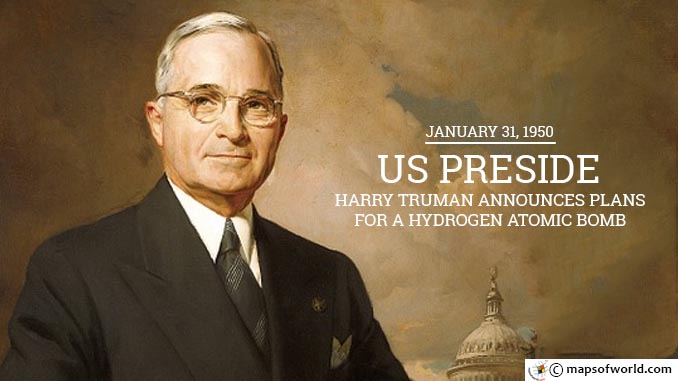On January 31, 1950, responding to an escalating Cold War and an imminent need for the possession of thermonuclear weapons, President Harry S Truman announced his decision to approve work on a Hydrogen bomb. In the later part of the 1930s, nuclear fission was discovered. With this momentous discovery, the race to creating the first atomic bomb in the world set off. In the US, this dream came about from Albert Einstein’s letter to President Roosevelt which detailed out the possibility of creating a bomb of hitherto unknown capabilities from Uranium. In 1942, Robert Oppenheimer engaged a number of physicists at the Radiation Laboratory of the University of California Berkeley to study and decide the viability of the thermonuclear problem. These physicists were responsible for the development of the atomic bomb and at the same time delved deeper into the physics of thermonuclear dynamics. The studied the nuclei of heavy hydrogen or deuterium and discussed the possibility of exploding it. These physicists were ultimately of the opinion that convinced that a thermonuclear explosion could be carried out. This initial ground work led to the establishment of the Los Alamos National Laboratory in 1943. Under Oppenheimer’s supervision the laboratory was created. Edward Teller and Oppenheimer soon put together the group of scientists who would work at the laboratory. During that period not much time and resources were dedicated to thermonuclear research. The immediate need of the hour was undoubtedly an atomic bomb. Intensive work was undertaken on the Manhattan Project which was directly headed by Maj. Gen. Leslie R. Groves. The atomic bombings of the Japanese cities of Hiroshima and Nagasaki in 1945 by the US during the closing stages of World War II, however, shed a new light on the ongoing work. By the end of the war most of the scientists of the Los Alamos lab refused to work on a hydrogen bomb (said to be 800 times as potent as the atomic bomb dropped on Hiroshima) and left the lab. Most of the scientific community was of the opinion that the US had no need for a thermonuclear arsenal. The escalation of the post-war Cold War, however, made it imperative that the US possess an arsenal far more advanced that the Soviet Republic. The arms race had just about begun. There were conspicuous differences over the issue of a Hydrogen bomb, even within the Los Alamos lab. While Edward Teller passionately supported the development of a “super”, Robert Oppenheimer, Enrico Fermi, and Isidore I Rabi were vehemently opposed to a thermonuclear weapon. In a Hydrogen bomb, the yield is virtually limitless since deuterium and tritium (hydrogen isotopes) are fused into helium causing a release of limitless energy. “Since no limit exists to the destructiveness of this weapon, its existence and knowledge of its construction is a danger to humanity as a whole”, wrote Fermi and Rabi in their report. The General Advisory Committee convention of the Atomic Energy Commission, headed by Oppenheimer, convened to consider the creation of a thermonuclear bomb. The committee unanimously recommended against such a development. Teller, however, decided to meet Sen. Brien McMahon, chairman of the Congressional Joint Committee on Atomic Energy and stress on the development of the Hydrogen bomb for the security of the nation, precipitating the need for a decision from the highest office – the President of the US. In September 1949 the security departments of the American, British and Canadian governments confirmed the occurrence of an atomic explosion in the Soviet Union. It looked likely that the USSR already had or would soon start work on thermonuclear weapons. President Harry S Truman commissioned a special committee of the National Security Council to debate the production of a hydrogen bomb. The committee with members such as the Secretary of State Dean Acheson, and the AEC chairman David E. Lilienthal, recommended the production. The President attended the committee meeting on January 31, 1950. He asked, “Can the Russians do it?” When the committee agreed that they could, Truman authorized production of the H-bomb and said, “We have no choice, we’ll go ahead.” The same day, a public announcement was made that the President had directed the Atomic Energy Commission ‘to continue with its work on all forms of atomic energy weapons, including the so-called hydrogen or super-bomb’. Savannah River, South Carolina, became the chosen site for the production facility of the hydrogen bomb in 1951. A year later, in 1952, the US successfully tested its first Hydrogen bomb at Eniwetok Atoll in the Pacific. USSR followed close at heels and tested its own in 1953. By 1961 the USSR was reputed to have had a weapon with the explosive force of about 60 million tons of TNT. By the close of the 1980s the known nuclear powers of the world had about 40,000 thermonuclear weapons in their possession. You may also like : January 31 1917 – Germany Resumes Unrestricted Submarine Warfare
January 31 1950 – US President Harry Truman announces plans for a hydrogen atomic bomb
On January 31, 1950, responding to an escalating Cold War and an imminent need for the possession of thermonuclear weapons, President Harry S Truman announced his decision to approve work…
458
